Hello friends—
I haven’t slept well for the last week or so because last week, I met a man who was so handsome that he ruined my life for several days. To give myself a break from my intense self-hatred during my sleepless nights, I’ve been thinking about some of my favorite things: how the internet is just Calvinism, Veblen and emulation in the digital context, and the harrowing aridity of modern secular life. In short, I’ve been thinking a lot about how Spotify Wrapped is just another example of the ways we’ve turned to apps and platforms because we no longer go to confessors or priests or preachers. We can’t find Salvation in the app store, but we can find its imitators.
To be clear, I am an atheist. I have no qualms about that. I am in no danger of converting to anything. I feel that there is something particular about the way a Protestant loses their faith that precludes ever finding one’s way into someone else’s religious catchment. I was raised very Baptist, which means that I have, at core, this view of there being two kinds of people: the saved and the damned. And in becoming an atheist, I permanently conscripted myself into the damned category. I don’t believe in an afterlife or in God, but also, I feel that this lack of belief somehow marks my soul out for eternally bad treatment. Such is the life of the culturally Protestant. I won’t speak for other people, but I grew up with a lot of religious trauma.
Church, meaning both the physical place and the social aspect of being brought up in a faith tradition, was the site of a lot of pain and suffering for me. I was taught to hate myself in ways both obvious and more insidious. There was a great emphasis placed on obedience and the giving over of one’s personal authority and agency to something greater than oneself. We were taught to subvert ourselves and to obey. Even when I was being hurt. Even when I was being molested and abused. Even when I was alone with myself, I was under constant surveillance. My God was not a loving God. He was an all-seeing, all-punishing gaze from heaven. I don’t miss that. But I was shaped. I was molded. I’ve left but it hasn’t left me. But that is a boring story. One lots of people know because they have experienced. I imagine this must account for why an increasing number of Americans do not identify with organized religion.
For me and for many of my closest friends, organized religion was an instrument of oppression and terror. I am never surprised when someone says they don’t believe in God. I am never surprised when someone says they are suspicious of organized religion. Never.
But despite all of that, I do find it funny that despite this, so much of modern fashion and culture seems to draw a lot of images and modes of thinking from, well, monastic life.
This week is the start of Spotify Wrapped season to all who celebrate. For those who do not, Spotify is a music streaming platform. Think Apple Music, Tidal, Pandora Radio (those were the days), Rhapsody, etc. For a fee, you can even stream without ads. There’s also a function that lets you listen offline, which means, to people like me who grew up in the age of physical media, like, listening the regular way. Each song you play ends up in your library in some form or another, either in a playlist called “Recently Played” or “Liked songs” if you tap the heart or thumbs up symbol. Or you can save whole albums to your library. This is different from downloading the songs. By adding them to your library, you’re essentially bookmarking the songs for easy access for the making of playlists and what not. Downloading is to enter the semi-permanent though still ephemeral intermediate state of being able to play your music from your device without the use of an internet connection. A temporary license. Like renting the music.
Spotify also features curated playlists inside of curated moods and vibes. You can play new releases in the Indie Folk category or you can play Acoustic Coffeehouse or Electric Workout or Fresh Rap or Lo-Fi Beats. Users also can curate playlists. This is particularly nice if you’re looking for the soundtrack of a favorite show from when you were young because there are probably playlists from those shows assembled other fans. These unofficial soundtracks are pleasing little excursions into memory. My ex and I once exchanged playlists that we had made for each other. I still listen to his sometimes. There are moments when I know what vibe I want but not what particular song, when I know I want to listen to some high, keening folksy melancholy mouth sounds but can’t remember a single artist who fits the bill. So I’ll go on Spotify and listen to an Indie Folk playlist until the right kind of song comes on, and then I’ll use that song to generate a radio, which is really just another name for a playlist of like songs. Then I’ll spend hours just being melancholy and looking out my window, spiraling deeper into a mood or vibe I’ve selected for myself, each song more or less what I was after. Sometimes, a song I don’t like will appear, and then I’ll obliterate it with a thumbs down and the algorithm will adjust itself and fly straighter and truer to my desired degree of sadness. In this way, my feeling is refined and so is my playlist. The more stringent you are, the more particular the sound, though I imagine there is some interval that is too fine for Spotify to parse, a limitation in the algorithm. After all, code is not sensibility, no matter how much it might seem to be.
Anyway, Spotify Wrapped is interesting to me because it scans all of your usage data of the app across whatever devices you might have used it on, and performs some set of analysis upon these data. The result is a “personalized” profile rendered in easily shareable graphics that reveal such things as the total amount of minutes you’ve listened to music on the app in the last year, the genres you’ve listened to most, the artists you’ve listened to most, the songs you’ve played the most, and, this year, a kind of Meyers-Brigg archetype predicated on your listening preferences. In short, the Spotify Wrapped takes the seemingly random, personal course you take through the universe and reflects it back to you, articulating something about who you are and what you feel and what you value. It renders visible the seemingly invisible elements ot your personality and life. It seems to say that in the deep disordered chaos of arbitrary human experience, there is some order to it, and that order is your personality, some immutable, mysterious facet of personhood that governs who and what you are. Every Spotify Wrapped is a manifestation of this order, an argument that there exists an order out there.
We love Spotify Wrapped because it tells us who we are. It performs a Fourier Transform on the apparent noise of life and decomposes it into neat categories that we can then use to retrofit a personality or archetype. Oh, I’m such Pop Trash. I’m in the top .001% of people playing Renaissance, let’s goooo. Oh, I’m so into Melancholic White Boy Music. Bon Iver Heads, Rise Up! Etc. While we have been commuting, sorting our spreadsheets, making our sad solo dinners, getting ready to see friends, running late, reading, writing, painting, crying, jogging, thinking about jogging, sitting by bedsides, holding hands, going on dates, driving to the river, shopping for gifts, practicing our coming out, practicing holding our breath, waiting to be called back for blood work, processing claims, and doing all the thousand things we must do in a day to get by, we have been, perhaps, playing music. Not always listening. Sometimes singing along. Sometimes crying along. Sometimes seized by a desire to hear that song that our mother used to play when she got dressed for Saturday night. In busy, busy mess of life, music was there all along, in the background. We may not remember what were playing on the train the day we stepped off and there was a man with a gun on the platform. We may not remember what were playing in the back of the car on our way to Thanksgiving with a friend. We may not remember the first song we played at the start of the year as we hoped it would be better than the last. We may not remember that. But Spotify Wrapped remembers.
It does more than remember, too, it offers you a record of this time and uses it to say something about you. Here are your Good Works. In easily shareable format that can be exported to both Instagram and Twitter. It’s this element of sharing that makes for an even more interesting business. Because it would be one thing to get your Wrapped and simply sit with the fact that you’ve played the cast recording of A Strange Loop more times than you might otherwise want to admit publicly (it’s really good though). But no, it must be shared. Look at who I am as evidenced by my preferences. Here, look, my personality has been transmuted into colorful graphics that will tell you something about me and my taste and my taste will mark me out in some particular way. Running through the logic of the Spotify Wrapped as in most of sharing things on social media is the idea of the Elect. I don’t mean that this is a Spotify only thing. So much of contemporary life is predicated on the Elect. Pecuniary emulation—mimicking the mores and fashions of a cultural elite—is predicated on the Elect. Pecuniary emulation is what drives that new breed of Cultural Elect, the influencer.
It might seem that these things are in opposition. After all, isn’t the appeal of sharing Spotify Wrapped that one can demonstrate one’s singular taste and personality. One’s own particular musical affinity. Isn’t it an example of the anti-influence, an attestation of one’s individuality? Well, yeah. But I think the notion of an individual personality at this point in cultural history is basically an aesthetic posture within the larger culture of influencing. I will try to be clearer. The dominant cultural mode right now is emulation and mimetic desire. In order to be imitated, one must prove that one is worth imitating, which means proving that you have an individual point of view. An individual sense of self. As Freud says, those who have retained their narcissism are appealing to those who have surrendered their narcissism. To acquire social and cultural capital, one needs to draw mimetic investment. To draw mimetic investment, one needs to signal that one is singular. And one signals that they are singular though a set of signifiers—which themselves may be imitated from others. That is why influencer content seems to belong to a genre, juiced up with mimetic thrall.
Anyway, Spotify Wrapped belongs to this set of signifiers, I think. Not that every instance of posting your Wrapped is you trying to exert mimetic thrall on others, but the Wrapped does, in certain, serve that purpose. Why else would it tell you that you’re in the Top .65% of Fleet Foxes listeners? Or that you listened to Rachmaninoff more than 99% of other listeners world wide? Why do we have a leader board for individual listeners of music? What is the function of this stat if not to create another emblem to be used in service of mimetic thrall? It’s all very sus to me, tbh.
It's not all fun though. There was a viral tweet responding to the fact that some people have listened to over 100,000 minutes of music this year. The person asked “Do y’all ever just sit with your thoughts?” The answer came briskly: shut the fuck up. Some people, annoyed by the ubiquity Wrapped posts on the timelines, snapped and said, “Share that with your therapist, leave me alone.” Or they said things like, “Oh, very cool, you listen to esoteric music. I only listen to Taylor Swift.” In short, the usual dynamic on social media of people feeling judged by the expression of someone else’s personality and preferences, and then responding with, well, judgement. On Twitter especially, it is so easy to mistake one’s annoyance with something for an actual critique of that thing.
There were other weird things at play with Wrapped this year. There were complaints about how Spotify was creating its categories and genres which created a skewed sense of people’s listening habits. There are probably many examples of this, but the one I saw trending on social media a couple days before Wrapped went out was Dream SMP, which is a Minecraft server started by the YouTuber Dream. For some reason, Spotify has turned his playlist into a genre, absorbing many artists into it. Obviously, genre designations (particularly in a post-Pandora radio world) always have an element of arbitrariness to them. They are fugitive by nature. But this does seem to be…particularly arbitrary. And people were mad because Spotify was classifying music they liked and enjoyed and identified themselves with as something else, something quite different. How could they post their Wrapped to their timelines if all their friends would think they were listening to Minecraft music?
Anyway, back to aridity of secular life. I have been thinking lately about the things that people do that have the feeling of monastic or religious order about them even as the people doing them would probably identify as atheist or nonreligious. I am thinking of the world of journaling and planning influencers in particular. Sometimes, I spend a lot of time on Instagram looking at beautiful notebook layouts. Some of these things are really works of art. The careful inlays and gold leaf and sharp, orderly lines. The crisp, perfect handwriting. The ingenuous ways of tracking one’s mood and diet and thoughts. Making plans months and months and months in advance, tracking the progress of those plans with colorful charts and graphs. Doing watercolor and brilliant drawings and illustrations. There are moments when the planners themselves sound like old manuscripts, creaky and pleasantly crackly with paper and pressed leaves.
BuJo influencers often have this quiet, murmuring way of speaking. Or sometimes, they are effusive and bright. They talk about how planning calms them, centers them. They have their planners for work, their planners for family, their planners for their therapy, their planners for pets. Some keep just one planner. Some keep five. Some have a different one for different phases of life. I once watched a video of a man setting up his planner for work, but all his plans were about making videos about planners. And I wondered if he ever experienced existential dread realizing that the overwhelmingly busy life that had given him the planner habit that had made him YouTube famous was now gone and all he had were plans for making videos about talking about plans.
Related to BuJo Influencing but distinct from it are a cohort of Influence spaces that have to do with making or doing things by hand. Think your handwriting influencers (yes, it’s real), fountain pen influencers, jam making influencers, pottery influencers, gardening and farm influencers, woodworking influencers, and on and on. The Maker Influence space is permeated by a casual but enthusiastic ethos of doing things by hand to find onself in an overproduced contemporary world. The Maker Influencer talks about the feel of materials in the hand and the calming effect of just doing it slow and doing it right. I grew up on a farm, and I relate a lot to that sort of stuff. After all, I’ve recently acquired a lot of what I call analog habits. I try write by hand (always a fountain pen) at least an hour a day now. I browse and look at notebooks on my lunchbreak, holding them in my hands and admiring different kinds of paper. I try to listen to vinyl at least twice a week. I shoot film photography. I try to read physical books. I don’t think these things are inherently better. I enjoy them because they do bring me a little closer to the physical world and I have missed being physical.
But also, it’s funny to me watching people discuss these habits in comments sections as though they were novel or new when in fact, today’s influencers are simply reinventing parochial school in both habit and mind. I tweeted this recently and somebody said something really funny like, “Everybody wants to be a Quaker.” And, like, yeah. Kind of. It makes sense though. The secularization of life, concomitant with the industrialization of life, has led to, well, a pervasive alienation from ourselves and others. In America, this is coupled with the death of WASP mass culture—which is a good, to be clear—but then, well, we’ve had nothing to put in its place. And so people wander around in the great dusty plain of culture, looking for something, anything to tell them who they are or what their actions mean.
On Instagram, I saw a product advertised for…so many American dollars. This product was a set of notecards for making to-do lists in the immediate, middle, and far term. They came in a hand-carved wooden holder. I thought, like, “Wow, $200 for a to-do list?” I looked it up on YouTube to see if there were views—there were, obviously. People talking about how you aren’t paying for the cards or the holder, but the ”system.” The system meaning…organizing your goals into the categories of today, later, and some day or something like that. That was their whole brand. Cards made of medium-weight card stock and a wood card holder and the fact that you were buying these objects so that you could organize your thoughts.
Peak Parochial Core seems to be a response to an era without meaning. A way of smuggling into secular life some of the vibe and air of monastic order without all of the harrowing Judeo-Christian trauma. And honestly, I can’t blame them. I too want to live in a small, bare cottage and drink mineral water and wear minimalist clothes and grow plants and eat root vegetables and write with a fountain pen on good paper and keep in touch with my loved ones with long letters about my inner life, the mysteries of which have been revealed to me through inward study and meditation. And in the meantime, I guess we’ll just DM and talk about the results of our Spotify Wrapped and our birth charts and sip cucumber water in glasses we bought from Instagram.
Every age in every place has its crisis of meaning. I mean, hello, the Protestant Reformation. Hello, the Great Awakening. Hello, the World Wars I & II, the Cold War, the Civil Rights Movement, and many more between. Spotify Wrapped, I think, appeals for all the same reasons that all the other things appeal to us. Things like Meyers-Brigg, Jung, Buzzfeed Personality tests, Astrology, Harry Potter Houses—the great celestial transit of archetypes. It is one of the main modes by which we live now and consume and engage art. We turn everything into a series of archetypes to be either identified with or disidentified with. I’m such a Cersei. I’m such an Alicent. I’m such a Maxine Shaw. I’m such a Carrie. I’m such a Richie.
Spotify Wrapped then is just another entry in our book of archetypes. It’s a little kernel of meaning. It’s an optimistic gesture, one that speaks to the existence of an order in all the chaos of our lives. We click and nervously wait while it tabulates and calculates and sorts us and it seems to speak with the authority of the almighty as it pronounces our names and tells us who are so that we might learn to speak to others of those far, dark reaches of ourselves.
Plus, it’s just fun.
b



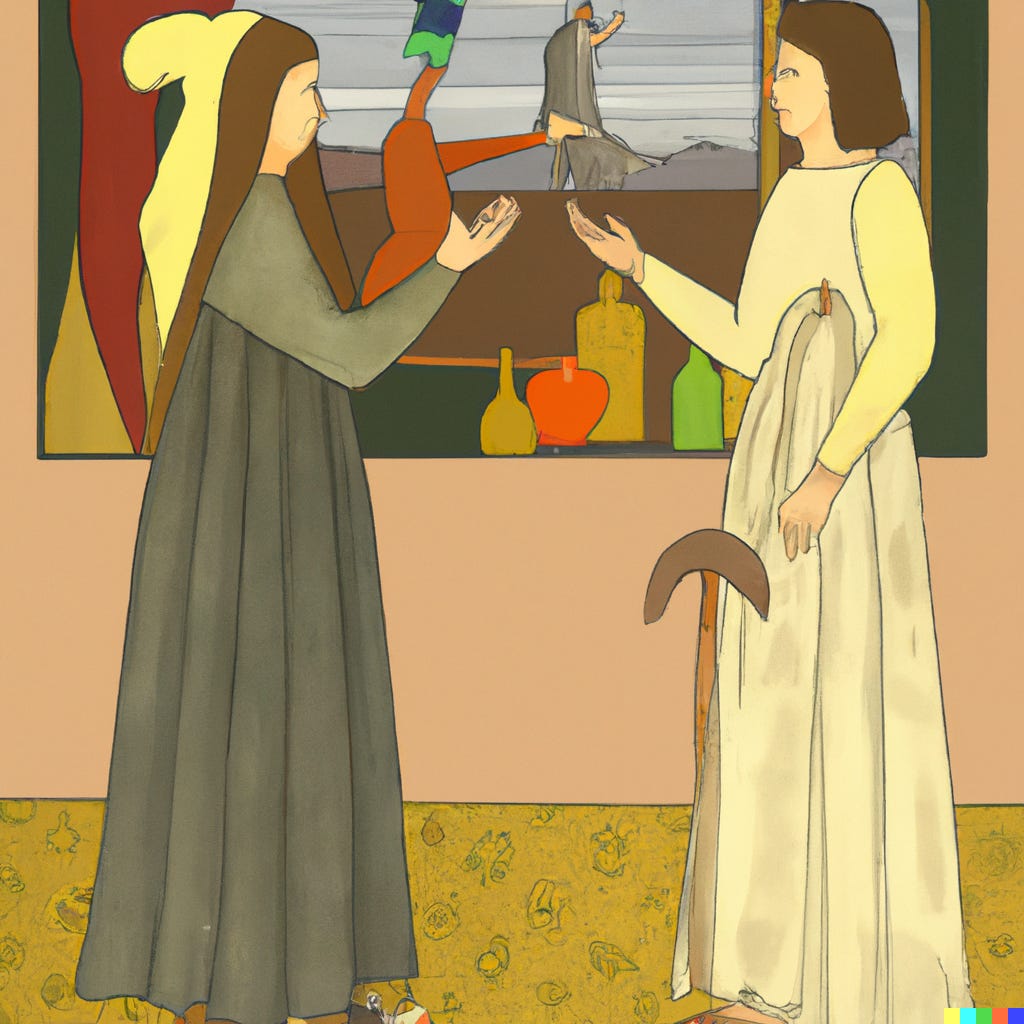
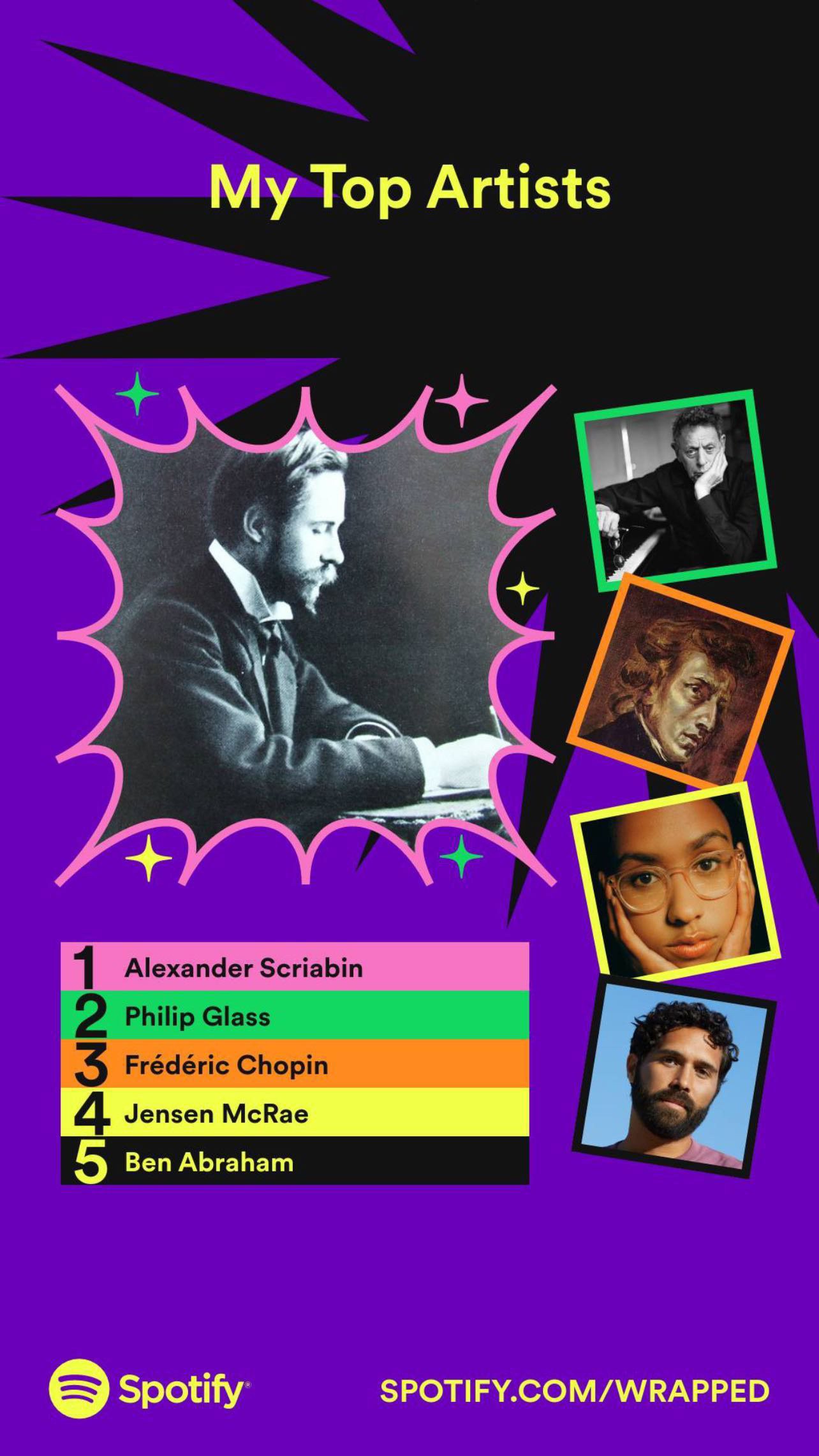
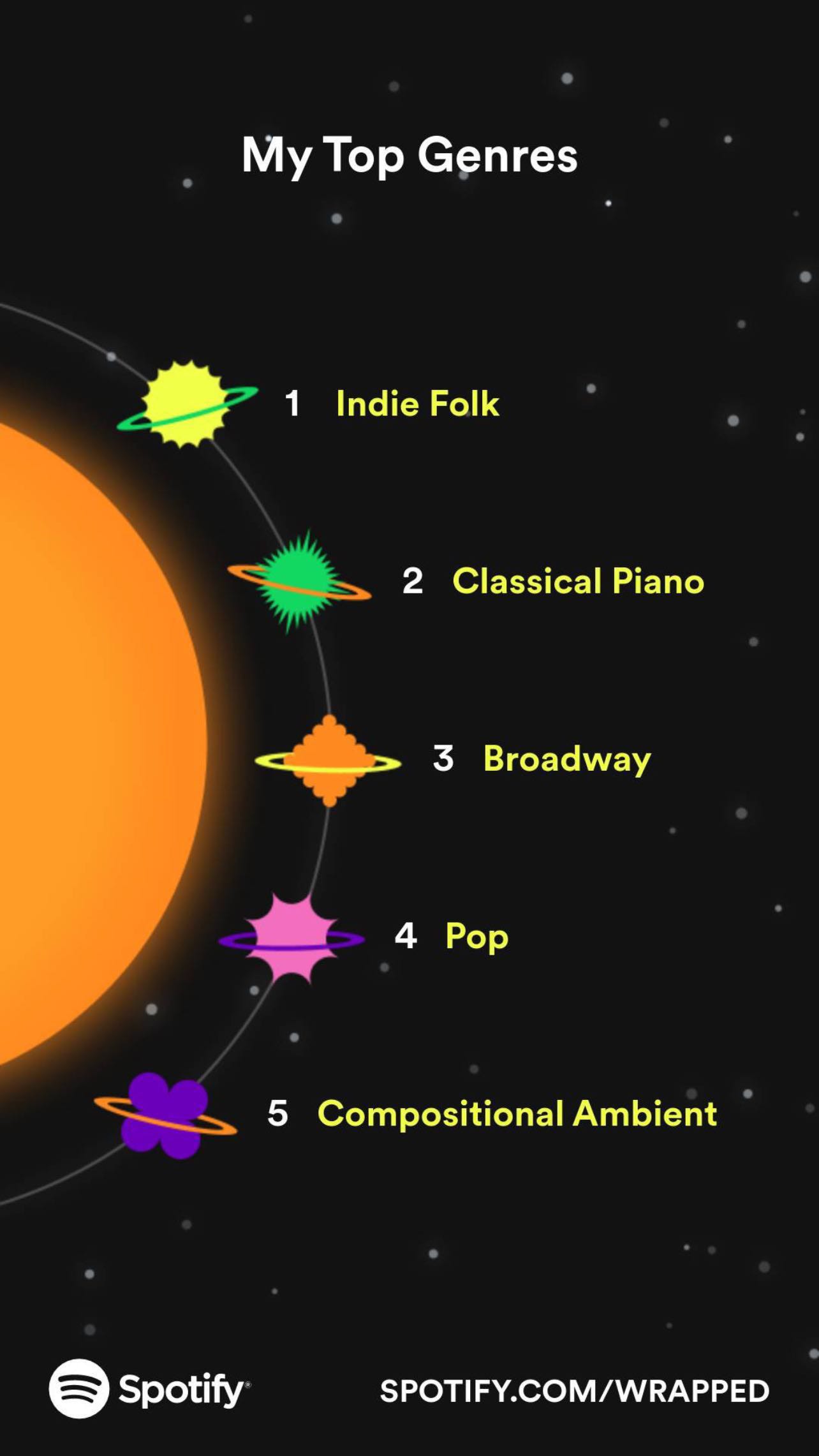
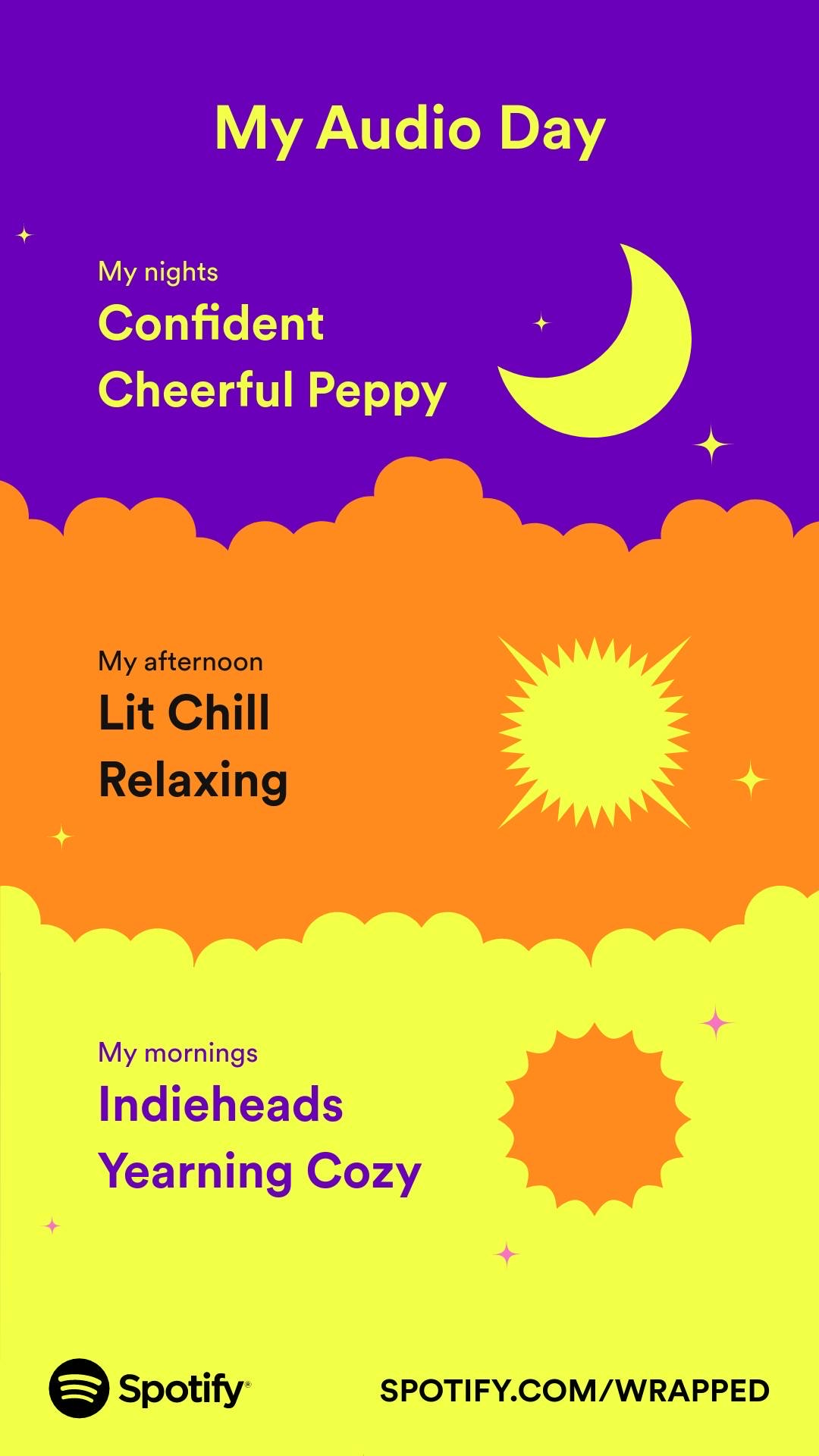
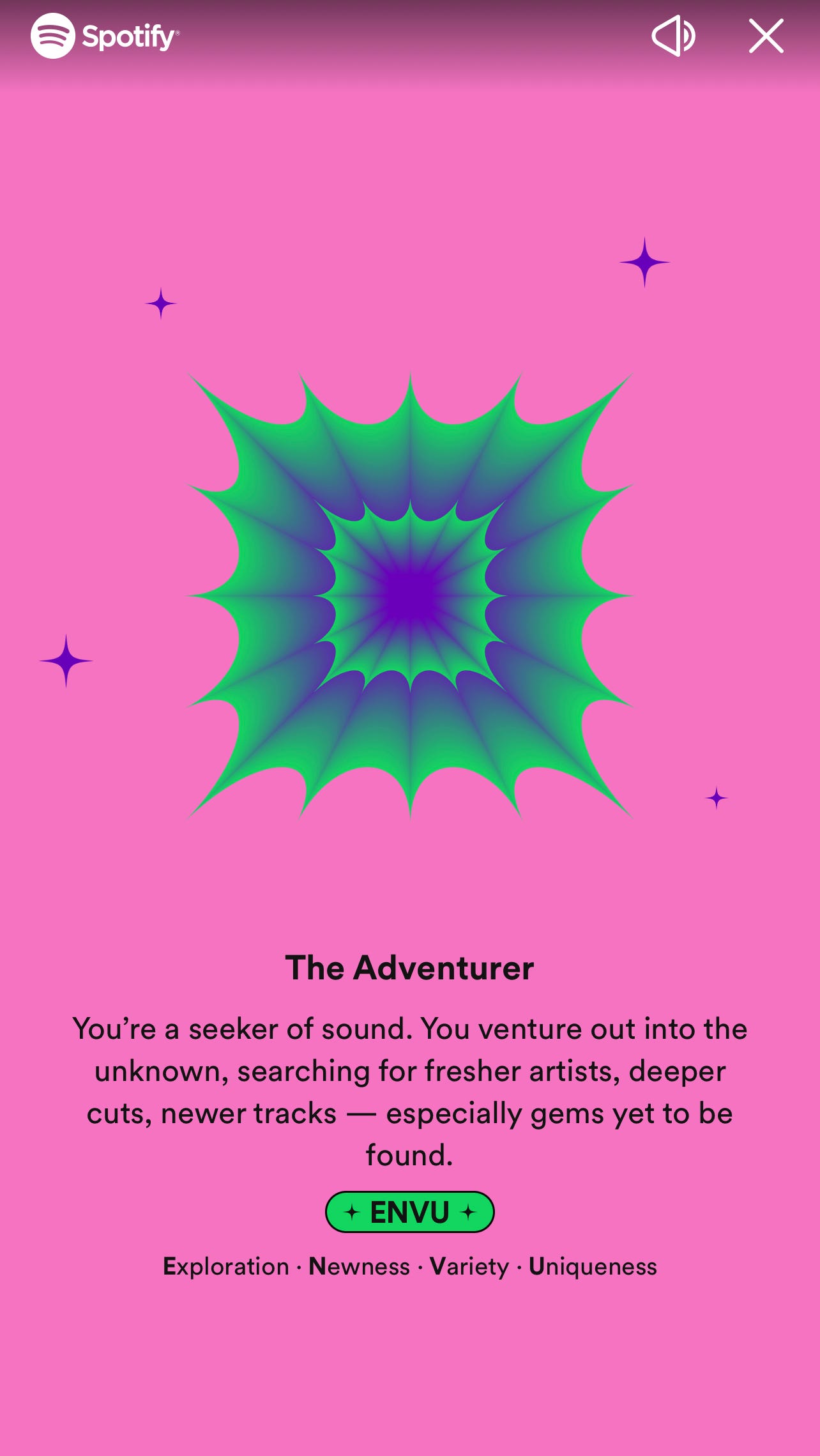
I guess we haven't evolved so much from the days when your entire personality (your entire being, even) could be summarized by the song lyric you put in your AOL away message.
Although I guess the fact that it's not a signifier you apply to yourself, but one generated by the all-seeing, all-knowing Algorithm is significant.
Everyone in my family but me is obsessed with Apple Watches and FitBits and all that stuff they use to monitor how many steps they're taking each day. I find that kind of surveillance, even self-surveillance, incredibly triggering, but YMMV. It's like the ghost of Steve Jobs is accruing merit points for them in heaven or something. We are so desperate to reinvent the Panopticon.